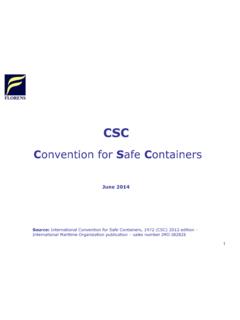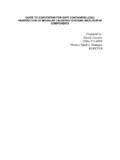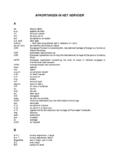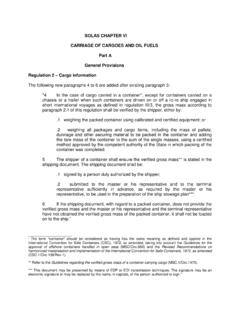Transcription of WNTI Best Practice for Checking Shipping …
1 WNTI Best Practice for Checking Shipping ContainersPrior to Loading Drums of UOC and Before DispatchGOOD Practice GUIDEWORLDNUCLEARTRANSPORTINSTITUTEWNTID edicated to the safe , efficient and reliable transport of radioactive materials3homecontentsWNTI Best practices for Checking Shipping Containers prior to Loading Drums of UOC and Before DispatchTable of contentsIntroduction4 Background introduction4 Consignor producers empty Shipping container inspection checklist5 External Checks6 Internal Checks6 Overall suitability for purpose7 Consignor (producer senders) packed Shipping container inspection checklist7 Suggested specification for Shipping containers to be used for the transportation of UOC8 Combined Shipping container Indemnity and DRum and Shipping container Cleanliness Form9 Photographs10 This guidance document introduces and describes thechecking of Shipping containers upon receipt at thecontainer yard and prior to loading at the Consignorproducer s facility and subsequent dispatch to the Consigneereceiver s facility.
2 The document may be used to assistConsignee producers in the development of their individualoperating documentation and parties are encouraged toadopt and apply the information in whatever format theyfind most appropriate and applicable to their needs,requirements and individual has been prepared for use by the World Nuclear TransportInstitute (WNTI) members and other stakeholders whotransport radioactive materials in Shipping containers and isnot a work instruction nor should it be seen as suggestingsome form of prescriptive or particular format that should be adopted by industry introductionThe transportation of uranium ore concentrates (UOC) is a regular occurrence practiced daily utilising supply chainroutes traversing public roads, railways, international waters, Shipping ports and container is packaged in steel drums that are securely stowedwithin twenty foot general purpose Shipping containers; the workhorse of the modern day Shipping containers are subjected to a high degree of wear,tear and damage and whilst leasing companies have anobligation to maintain their fleet of Shipping containers to meet strict guidelines, there is also an obligation forindividual users to ensure that the equipment that they are receiving and subsequently using is also fit for WNTI document provides guidelines covering thepractices that Consignors should adopt in order to fulfilltheir respective obligations to the overall security, safety andhealth of the communities and environments through whichtheir uranium ore concentrates are Consignor producers have an obligation to themselvesand to their on-carriers to ensure that their product ispackaged correctly and stowed securely within shippingcontainers that comply with international standards asrequired by the IAEA, IMO.
3 European and North Americancompetent authorities as well as meeting local domestic or other applicable regional is an additional requirement for each Consignorproducer to ensure and certify that both the drums and theshipping containers are clean and free of any radioactiveresidue or associated surface producers actually require two separate checklists;the first addresses the requirements associated with ensuringthat the empty Shipping containers are suitable and fit forpurpose. The second checklist is required to check that thepacked Shipping container meets all necessary requirementsmaking it ready to be is a requirement for two separate types of Consignorproducer focused Shipping container producer empty Shipping containerinspection producer packed Shipping containerinspection all Consignee receivers have an interest in ensuringthat the cargo shipped to them by their Consignors arrivesin good condition together with an obligation to providefeedback to inform their Consignors of any situationwhereby the cargo may have been compromised is an additional regulatory requirement for eachConsignee receiver to ensure that when the de-stuffedshipping containers leave their premises they are free of anyradioactive residue or associated surface contamination inaccordance with IAEA free release producers empty shippingcontainer inspection checklistThere is a requirement for all Consignors to comply with the Convention for safe container s
4 (CSC) and to conform tothe Shipping container packing requirements of the UnitedStates Customs and Border Protection, Customs-TradePartnership against Terrorism (C-TPAT).Additionally there is a further requirement to comply withthe IAEA Regulations for the safe Transport of RadioactiveMaterial (TS-R-1) so that any drums and or shippingcontainers used for the transportation of uranium oreconcentrates must have less than Bq/cm2 of above requirements apply irrespective of whether the Consignor is utilising leased Shipper Owned (SOC) orShipper Supplied units provided by the Carrier (ShippingLine).In most situations, mine sites are located long distancesaway from container yards. Good Practice suggests theutilisation of a marine surveyor to undertake pre acceptanceinspections of Shipping containers prior to transporting tothe mine order to undertake the inspections, the marine surveyorshould be provided with a copy of the Consignors shippingcontainer there is always the opportunity for damage to occur to the Shipping container during handling and transportbetween the container yard and the mine site.
5 A furtherinspection should be made both internally and externally toensure its structural integrity upon receipt of the shippingcontainer at the mine defects be found at any stage during the aboveshipping container inspection process it is good Practice todigitally photograph the defect in order to provide feedbackto the marine surveyor and or to the Shipping may wish to include additional checks as theydeem appropriate for their particular producers empty Shipping container inspection checklist12345 Inspection locationDate / Time arrivedShipping container NumberDate / Time of inspectionShipping container Safety Plate NumberNature of defectExternal Checks Record Shipping container number details, name ofperson undertaking the inspection and the date ofinspection. Record the Approved Continuous Examination Program(ACEP) and CSC approval details, Shipping containertype, date of manufacture, maximum gross, stack andshipping container tare weight details for the shippingcontainer indemnity and cleanliness certification.
6 Check that the ACEP identification label or the validityof the CSC container safety approval plate and re-inspection date has not expired. Check the undercarriage to ensure there is no damageto the under floor timber, the Shipping container floorrails or the box Tyne channels etc. Extreme care must be taken to ensure worker safety when performing thesechecks. The employee should never stand underneaththe Shipping container when performing these checks. Check that all exterior surfaces have minimal surfaceand no major structural rust. The Shipping containershould been in good condition and have a visuallypleasing appearance. Even though the shippingcontainer is acceptable for use, the general appearanceof the Shipping container has a significant impact onpublic perception. Undertake visual checks to ensure there is no obviousdamage, holes or cracking of the external wall, roofpaneling or corner joints. Minor cracks in joints can be filled with silicon if required. Ensure that any bowing or warping of the roof or wallsurfaces fall within the stated Institute of InternationalContainer Lessors (IICL) limits.
7 Check both doors to ensure they are not distorted andclose tightly; that all door fittings, locking mechanisms,door gaskets and seals are in serviceable order. Remove any previously applied placards, markings and associated warning or advisory labels. Check the top and bottom mounted corner fittinglocking structures for serious damage. Always feel free to record and document any issuesirrespective of them being considered good or bad asphotographic evidence is irrefutable and in the modernage of the digital camera is a cheap form of Checks Check that the Shipping container has been cleanedfree of any previous cargo residue material. Check thatthere is no dirt or debris left on the floor or the door of the Shipping container . Undertake a survey of the Shipping container prior topacking to ensure that no form of contamination ispresent. Check that all interior surfaces have minimal surfaceand no major structural rust. Undertake visual checks to ensure there is no obviousdamage, holes or cracking of the internal wall, roofpaneling or corner joints.
8 Minor cracks in joints can be filled with silicon if required. Ensure that any bowing or warping of roof or wallsurfaces fall within the stated IICL limits. Check that there is no damage or evidence of freshstaining to the Shipping container flooring. Ensure that the top and bottom securing lugs are bothappropriate and fit for use. Undertake a water proof test** to ensure the integrityof the overall sealing capability of the shippingcontainer to effectively prevent the entry or dischargeof material or moisture.**Water proof test: This is best done by entering inside the Shipping container and having someone close both of the Shipping container doors. Due to the extremes oftemperature experienced at many if not most mine sites,consideration as to the total time spent shut inside theshipping container must be given. Additionally cautionshould be taken as there is always the possibility thatresidual potent gases from the fumigation of previouscargoes could also be present.
9 Should any indication ofdaylight be seen through the door seals or from elsewherewithin the Shipping container it must be assumed that watercould gain entry and therefore the Shipping container shouldbe deemed unfit for checks6 Overall suitability for purpose Determine and sign off as to whether the shippingcontainer is fit for purpose. If suitable assign the unit as being ready to be packed. If unsuitable, do not pack the Shipping container , signoff the report, reject the unit and follow internalprocesses to have the Shipping container returned tothe Shipping container supplier. File and store copies of acceptance or rejection reportin line with internal operating (producer senders) packedshipping container inspection checklistAfter the Shipping container has been packed and well priorto preparing the Shipping documentation, each packedshipping container should once again be Practice suggests that wherever possible a personindependent of those specifically involved in the packing of theshipping container conducts a final external and internal checkaddressing the requirements above applying to empty shippingcontainers also addressing the additional items below: Confirm with those specifically involved in the packingof the Shipping container that no incidents occurredduring packing of the Shipping container that may have resulted in Shipping container contamination.
10 If a possible contamination incident did occur, confirmthat the Shipping container was emptied, cleaned and resurveyed. If resurveyed, confirm that survey results weredocumented and acceptable. Ensure that all drums are adequately secured. Check that locking seals on each drum lid are tight and that each drum has the applicable RadioactiveCategory label and Marine Pollutant labeling. Check that the drum details match the drum, batchand lot details against the Shipping container packinglog sheet. Conduct wipe tests on the external surface of alldrums. When using a well established and reliabledrum cleaning station, a random selection of drumscan be wipe tested based on statically samplingtechniques. Ensure that there are no obvious signs of residual orextraneous packaging or securing material. Close and lock the Shipping container doors applyingthe designated seal numbers as per the shippingcontainer log sheet. Clean and wash the external surfaces andundercarriage of the Shipping container to removeresidual surface dust or soil that could contain orsupport any form of contamination.





